
Road to agricultural modernization
Du Ying
China will prioritize agricultural development and rural areas to modernize agriculture by 2035.
However, two major challenges exist. First, the country’s huge population, limited agricultural land and water scarcity make China more suitable for labor and technology-intensive farm produce, instead of land-intensive products.
Second, most farmers in China are smallholders. The country’s 220 million rural households work on about 110 million hectares of farmland-the average plot per rural family is less than 0.5 hectare. In contrast, the average farmland size of the 2.1 million US family farms is 170 hectares, and the number is 18 hectares in the European Union. Furthermore, most Chinese farming households do not produce for sale, but sell whatever is left after meeting their own requirements. Besides, most farmers are smallholders employed in non-farming sectors on a part-time basis. At the end of 2019, agricultural earnings accounted for around 36 percent of the total income of Chinese rural households.
Smallholders are good at intensive and meticulous farming, using resources to the maximum. However, this production model is not conducive to the introduction of new technologies, the standardization of agricultural production, the agricultural sector’s market transformation, and the rapid enhancement of agricultural productivity.
Against the backdrop of accelerated industrialization and urbanization nationwide, the aforementioned problems will inevitably push up the price of domestically-produced agricultural products. This is the major reason for the continuously widening deficit in agricultural product trade since China became a net importer of agricultural products in 2004.
Over the past few years, however, some changes in China’s agricultural sector bode well for the country’s agricultural modernization.
There is significantly improved agricultural equipment. The government spending on agriculture increased from 235.8 billion yuan ($35.97 billion) in 2004 to 2.1 trillion yuan in 2019. As a result, damage to crop-growing areas from natural disasters during the period declined by 48.1 percent and the crop areas most severely damaged by natural disasters decreased by 51.2 percent, while the contribution of scientific and technological progress to agricultural output increased from 45 percent to 59.2 percent.
Substantial progress has been made in the structural transformation of the agricultural sector, with increasingly popular diversified management, higher proportion of high value-added farm produce, different regions exploiting their comparative advantages to the full and increasing efficiency of resource allocation. Therefore, China’s agricultural structure is moving in a direction more suitable for the country’s resource endowment.
Furthermore, the integration of the primary, secondary and tertiary sectors in rural areas has been further promoted, injecting fresh momentum into the agricultural sector.
New types of agricultural management entities have thrived in China. By the end of 2019, 36 percent of China’s total arable land contracted by households, or 550 million hectares, had been transferred, and the total number of new-type agricultural management entities (big, specialized operators, family farms, farmers’ cooperatives and agricultural enterprises) had reached over 3 million, cultivating more than 17 million professional farmers.
The labor productivity gap between agricultural and non-agricultural sectors has been shrinking since 2004.
Going forward, China should properly handle the following relationships. It should find a balance between enhancing self-reliance and using the international market. From the long-term and strategic perspective, China should place great emphasis on food security and self-reliance to feed its 1.4 billion people. However, ensuring food security does not mean becoming 100 percent self-sufficient in all farm produce. China is capable of utilizing the international market to its advantage, and it should do so.
Given the great regional disparities, China should also offer policy guidance for regions based on their comparative advantages. For instance, scale operation and mechanization of farming should be prioritized in regions focusing on open field crops, while technology and a labor-intensive development strategy should be firmly upheld in regions focusing on commercial crops to give full play to the advantage of quality products. China’s agricultural modernization should respect regional differences, instead of adopting a one-size-fits-all approach.
The agricultural modernization strategy must prioritize breakthroughs in agricultural technology. Only by increasing crop yields through output-growing technology can China lay a solid foundation for developing high value-added agriculture. With the development of mechanization, biotechnology, artificial intelligence and environmental protection, China can substantially increase the total-factor productivity of the agricultural sector.
China should further beef up support for the agricultural sector and improve its agricultural policies. It should further increase its input in agriculture, which accounted for 17.8 percent of the agricultural output in 2018, 11.4 percentage points lower than the average of the members of the Organization for Economic Cooperation and Development.
Besides, China should implement more differentiated and targeted subsidy policies, prioritizing main producing areas and scale operating entities to increase the efficiency of government subsidies.
The government should also strengthen the combination between fiscal and financial policy support for the agricultural sector, such as promoting agricultural credit and agricultural insurance to cover more rural areas.
The writer is former vice-minister of the National Development and Reform Commission and vice-chairman of the China Center for International Economic Exchanges.
